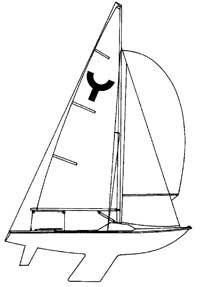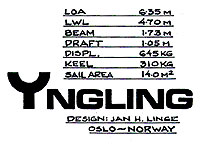In a nutshell, the Yngling is a sleek and seaworthy small racing keelboat (6.35 m (21′) LOA, 645 kg. (1422 lbs.)), succinctly described as an agreeable cross between a planing dinghy and a keelboat. Its design is classic, and its construction is durable.
Sailing Characteristics
One touch of the helm and you’ll understand the loving loyalty of Yngling owners worldwide. The boat simply sails beautifully.
Those familiar with the Soling will instantly recognize the Yngling as a “mini-Soling,” a description which is quite apt. In the Yngling (pronounced “ING-ling”), designer Jan Linge basically duplicated his Soling, making it smaller, more suitable for average-sized people, easier to trail (behind even a four-cylinder car), and less expensive to own. The Yngling shares the Soling’s sleek hull form, well-balanced rig, and responsive helm. While the Yngling is not as fast as the Soling, it is quicker, and more nimble. It turns more quickly and in less distance, and responds better to crew weight trim adjustments.
The Yngling is designed to sail with three crew (although two can handle it easily). Optimal crew weight is 400 to 500 lbs., so the Yngling accommodates both juniors and normally sized adults, and it is the ideal women’s racing boat (in fact, IYRU selected the Yngling for its first International Women’s Championship in 1994, and ISAF chose it as the boat for the 2004 Olympic women’s keelboat event). Sail controls on the Yngling are easy to manage, and the effects of small adjustments are felt by the crew. The Yngling sails in a delicate and fast upwind groove.
Design & Safety
In 1990 Jan Linge re-designed the interior of the Yngling, giving it a water-tight, raised, “double-bottom” cockpit sole. With “Elvstrøm” bailers on port and starboard just above the waterline, the boat drains water quickly under sail, upwind and downwind.
The Yngling is unsinkable: Class rules mandate that a boat have enough styrofoam flotation so that, if filled entirely with water, an Yngling can still float — with three crew aboard!
Construction & Value
Compared with similar keelboats such as the Soling, Etchells, Shields, Sonar, J-22, and J-24, the Yngling is the least expensive and easiest to maintain (a used Yngling can be bought for about the price of a suit of sails for an Etchells!). The Yngling is also one of the best values, beyond its low purchase price, due to its rigid one-design construction rules. Class rules mandate that Ynglings be built with hand laid-up fiber-glass, instead of cheaper and less-durable methods such as chopped fiber-glass. The benefit of this requirement is that the Yngling hull is extremely rigid and durable: hulls thirty years old are competitive with brand new ones. Such longevity in a fiber-glass boat is rare.
International Class Organizations
The Yngling has been an ISAF (formerly IYRU) International Class since 1979. Strong and enthusiastic class associations exist in two-thirds of European countries, Australia, and North America. National and regional regattas are held throughout these areas, and the world championships are hosted around the world, from Denmark to Australia to the USA.
Approximately 2800 Ynglings are sailing worldwide. The core of the fleet is a competitive but friendly group of long-time Yngling sailors. Additionally, Ynglings were commonly raced as training boats by Soling Olympians (and at least one America’s Cup skipper hopeful); now that the Yngling is itself an Olympic boat, top-caliber female sailors around the world are being welcomed to the class.
